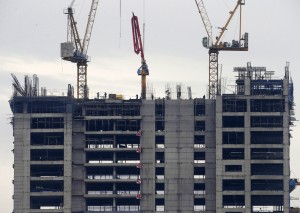Official macroeconomic forecasts were revised upwards this month as government officials aired a sense of optimism over the country’s prospects over the next three years.
The inter-agency Development Budget Coordination Committee (DBCC) disclosed the new set of economic assumptions, which all pointed to the sustained boom of the Philippine economy.
“We expect higher growth rates in the coming months. Consumption is still bullish, and spending will speed up,” Economic Planning Secretary Arsenio Balisacan told reporters late last Friday.
Balisacan said the government’s gross domestic product (GDP) growth target for the year of 6.5 to 7.5 percent was still attainable, despite a disappointing first-quarter expansion of 5.7 percent.
“On the supply side, industries will recover because they were slower than expected. Services will grow faster,” he said.
At the conclusion of the DBCC’s semi-annual meeting, officials listed the revisions to forecasts on trade, growth and the foreign exchange market.
The country is now expected to import 9 percent more this year than it did in 2013. This is better than the previous forecast of growth in imports of 6 percent. For 2015, imports growth is expected to reach 10 percent (better than the previous 7-percent projection), and for 2016, imports are seen increasing by 12 percent (versus the previous forecast of 9 percent).
Higher imports are an indication of increased domestic spending since more active consumers demand more products, both from local producers and from overseas.
Balisacan said the better projections for imports were also due to reconstruction efforts in the Visayas to repair damage caused by Supertyphoon “Yolanda” late last year. This rehabilitation was expected to take several years and over that time, increased importation for raw materials like steel and cement should be expected, the DBCC said.
Faster growth in imports is also indicative of the performance of the local exports sector, which economic managers were similarly bullish about. Some of the products exported by the country such as electronics are built partly using imported goods.
Growth projections for exports for 2014, 2015 and 2016 were kept at 6 percent, 8 percent and 10 percent, respectively. A new forecast of a 12 percent-growth in exports was announced for 2017.
The DBCC’s trade projections were all anchored on the expectation that economic conditions in advanced markets like the United States, Japan and Europe, would continue to improve over the coming years.
“The global economy is improving and we expect that to continue,” Balisacan said.
With economic conditions particularly in the United States improving, the DBCC decided to revise its assumption for the peso’s value against the greenback. This year and in 2015, the peso’s value is expected to average between 42 and 45 to $1, or weaker than the previous range of 41 to 43 to a dollar.


